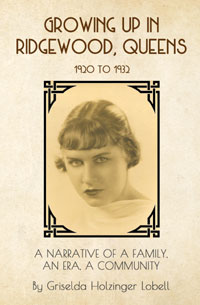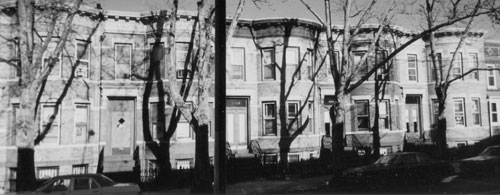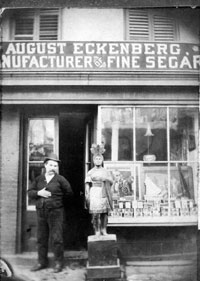After a long life people have stories – favorite stories that stay in their memory they tell over and over again. These stories shaped their lives, their personality and destiny – informing their decisions far into the future. Today stories from elders are more precious because so much has changed so fast - the history of their neighborhoods, the country as well as technology, social
values and lifestyles. Their stories inform our understanding of our ancestors and the past. My brother, Professor John Lobell, has been instrumental in bringing my parents’ stories to the public by publishing their memoirs - my father’s memoir “Of Things That Used To Be” (Nathan D. Lobell - 1911-1995) about his childhood as a Jew growing up in the Bronx  and now my mother’s memoir “Growing Up in Ridgewood, Queens 1920 to 1932” when the Germans who lived there were the majority. Their books are an interesting window into the past that stir
nostalgia for a simpler life when horse drawn pushcarts sold their wares on the street, the iceman came to your door, furnaces were fueled with coal, laundry done by hand, movies and records a novelty and ethnic food was fresh. and now my mother’s memoir “Growing Up in Ridgewood, Queens 1920 to 1932” when the Germans who lived there were the majority. Their books are an interesting window into the past that stir
nostalgia for a simpler life when horse drawn pushcarts sold their wares on the street, the iceman came to your door, furnaces were fueled with coal, laundry done by hand, movies and records a novelty and ethnic food was fresh.
Reading my mother’s book written in 1990 is like stepping into another world: the neighborhood of Ridgewood, Queens in New York City of yesteryear. Accompanied by photos, maps, diagrams and family trees, this memoir is a well-researched document.
This book is rich with tales of families who traveled from Europe, found work, wooed spouses, created homes, raised families, lost loved ones in the Great War and survived the Depression. 
Ridgewood is a now a landmarked neighborhood, which, when Griselda  was growing up, was mostly ethnic German with some Italian, Irish and a scattering of Jewish shopkeepers. The Italians ran the barbershops, vegetable stores and shoe repair. The butchers, bakers and grocers were German. The specialty stores (clothing, children’s furnishings, floor
coverings, etc.) were owned by Jews. The Germans struggled through changing demographics when developers began raising apartment blocks near their three story brick bays. was growing up, was mostly ethnic German with some Italian, Irish and a scattering of Jewish shopkeepers. The Italians ran the barbershops, vegetable stores and shoe repair. The butchers, bakers and grocers were German. The specialty stores (clothing, children’s furnishings, floor
coverings, etc.) were owned by Jews. The Germans struggled through changing demographics when developers began raising apartment blocks near their three story brick bays. This memoir chronicles the intimate life of middle class second-generation German families – their values, daily routines, womens’ roles, personal triumphs and tragedy. Griselda remembers in great
detail what schools were like, how street games were played, excursions to Manhattan, and a cycle of weddings, births and funerals. Family members took care of and lived near each other. Their schools were among the best in the world. It was also a world of fresh food: “The fruits and vegetables were unpacked, unchemicalled, unsprayed, unfrozen and unrefrigerated. In other words, nothing had been done to
ruin the natural flavor. Meats and fowl were unhormoned, milk unhomogenized, and dairy cream fresh and thick.” Some of the stories in the book are familiar to me and others are a surprise. What struck me is that when growing up in Great Neck my mother was sewing on her Singer Sewing Machine while other mothers’ closets were filled with expensive store bought clothes. But she
described sewing as an integral part of her household - watching her aunts and grandmother shop for cloth, study patterns and sew their own garments and curtains by hand. Household routines required a lot of hard work – changing the ice in the icebox – washing laundry in big tubs and hanging it outside to dry – heating irons on the stove – loading coal to keep the furnace going and emptying the ashes –
gardening – sweeping the porch and sidewalk – lemon oiling the woodwork – making homemade jams from wild berries - shopping daily and the rituals of cooking and preparing meals. Describing a world without television, Griselda wrote, “We had a wind-up Victrola in the kitchen and if Papa sold a story (he was a mystery writer) the first purchase on the way home from the bank would be a
classical record. These records were very expensive—sometimes as much as ten dollars, which was a week’s wages for most people. Caruso, Galli-Curci, Schumann-Heink, and many others who all sounded terrible to me, especially when the machine wound down in the middle.” Other forms of entertainment included silent movies, vaudeville and the thrill going to Broadway theatre.
Because most of our break-through advancements in medicine and technology occurred after WWII, in those decades without antibiotics pneumonia could lead to a missed semester of school or even early death. When Griselda made trips to the country with her grandmother to pick berries for preserves they risked traveling in a Model T with inadequate brakes. Women’s marriage and career status has changed radically since the
1920’s. Although some women worked in jobs outside the home, the terrible stigma of being unmarried then has happily been eliminated. As birth control was not readily available Griselda alludes to self-induced abortions when she writes that many married women often had “miscarriages”. However she did not explain exactly what methods they used. As a teen my mother had her heart set on attending Barnard College.
Her mother Florence ran the jewelry repair desk at Saks Fifth Avenue, but her income could not cover tuition, so her father John had to find a way for his writing to make the extra money. He did – by publishing a column in the New Yorker. My mother went to Barnard as a Political Science major and after three years became a member of the pioneering generation of women at Columbia Law School. She said that on the first
day of class her professor Karl Llewellyn told his students, “Turn to the right, turn to the left and look at each other because one of you will not be here. I was a wreck.” There she met my father Nathan D. Lobell and during their marriage they lived in Washington D.C., Great Neck, Manhattan and then Wilton, Ct. As technology exponentially changes our lives heading for global
meltdown “Growing Up in Ridgewood, Queens, 1920 to 1932” is a souvenir to take us down memory lane and reveal to younger people what life was like ‘back then’. Published by JXJ Publications
Available at Amazon
and Barnes & Noble |